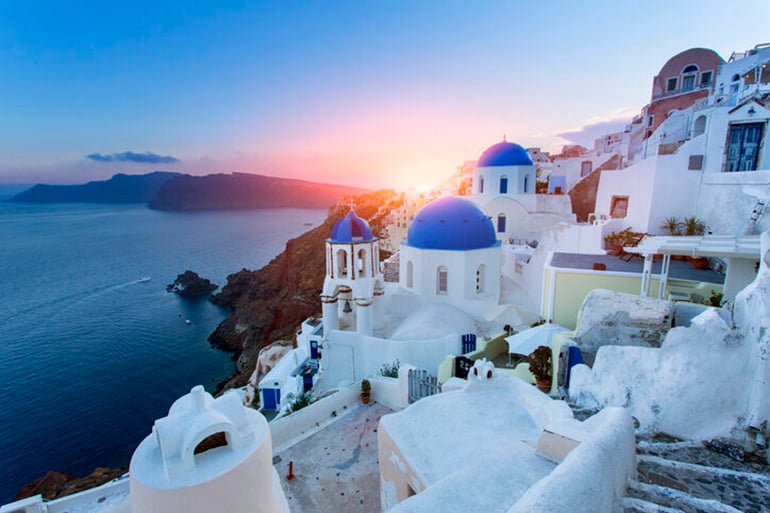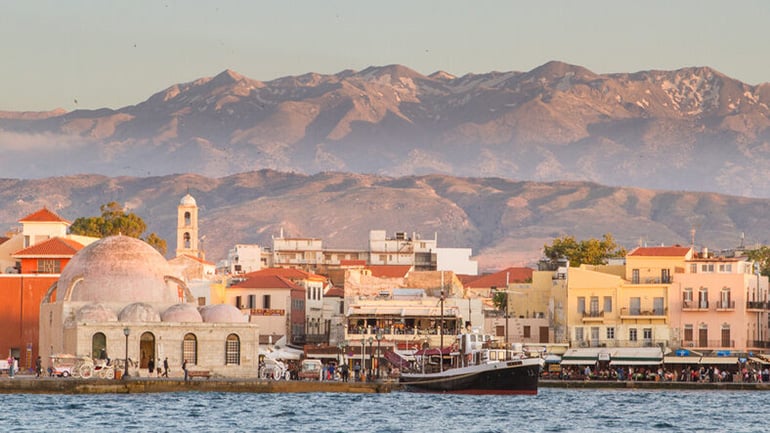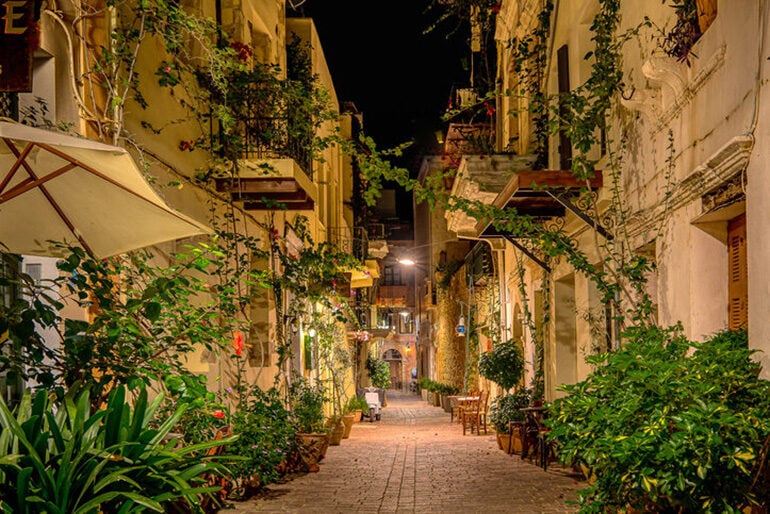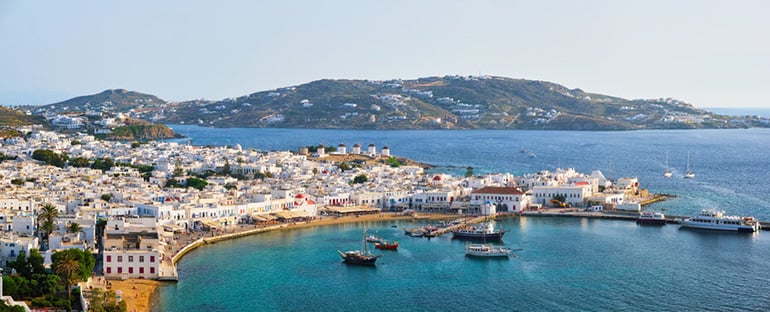Many travelers fantasize about going to the Greek islands. They imagine thatched windmills and blue domed roofs. They picture whitewashed buildings draped with bougainvillea, cobblestoned alleyways with courtyard restaurants, and towns built so that they look like they’re tumbling down a cliff face toward cobalt caldera seas.
What they don’t realize is that few – if any! – of these iconic images are set on the same island. Some don’t even know the names of the main ones, thinking no further on “Greek islands” as a destination than somewhere out in the Mediterranean (despite their being in the Cyclades).
All of the above is another reason travelers need to Plan with a Pro when it comes to their bucket list travel dreams. When they Ask a Travel Advisor, they learn all of these important details and – most importantly – how accessible and within reach this kind of vacation is.
 Santorini
Santorini
The Fantasy: This island’s capital, Fira (also someties called Thira), and its sister city Oia are two of the most iconic images of the islands off the coast of Greece and the most easily and immediately recognizable. White buildings that spill toward the sea and doorframes that seemingly lead to nowhere, framing clear blue skies … this is the Greek Isle of most peoples’ dreams.
The Reality: We know the island as Santorini, but to the Greeks, it’s also called Thera and Thira, matching the name of the capital. The land mass itself is located about 120 miles southeast of the mainland, and its airport is closer to the top of Fira while its main port is at the bottom. However, these days, ferries arrive at the new port, Athinios, an important detail to note, as most island-hoppers plan to move around by sea since Santorini is one of the only Cyclades Islands with a major airport.
Good to Know: Fira is more casual than Oia, which is rife with fine dining restaurants, and also more lively as it hosts more bars, clubs, and nightlife and dance venues.
 Mykonos
Mykonos
The Fantasy: Giant white windmills piled near one another, their thatched roofs standing out in contrast to the flatter roofs of the rectangular whitewashed cubes of the town, the Chora. Also, rollicking beach clubs on the shores and a gay scene that makes it among the top LGBTQ+ destinations in the world.
The Reality: All of those are accurate, but only to an extent. The windmills are not exclusive to Mykonos, but one near the harbor has been converted into a museum, so that’s fun. The white-on-white town architecture is correct, too, but Mykonos is flatter than those spill-down designs you see in Santorini. The town is relatively level, so much so that there is even a section that speaks to Venetian building influence more than those windmills, where restaurant balconies are built in suspended ledges over the land, with not even a beach to signal the change in terrain. And speaking of beaches, the ones on this island are celebrated, but may be farther apart and smaller than you expect, making a rented car or using the water taxi options to put on your radar. Some of the wider, longer beaches are divided between different club management; expect to pay wherever you go for chair rentals and the space the seating takes up. Also note that the beach scene and nightlife is seasonal, so beach weather and evening partying aren’t guaranteed nor year-round. Plan accordingly.
Good to Know: The peak months of July and August are crowded, especially when travel dates coincide with cruise ship stops. The good news is that it thins out midday and in the evening, when people aren’t scurrying to and from port. Also, there is an air alternative to ferrying to Mykonos via Aegean Air that will get you from Athens in 40 minutes, if you’re willing lose time to getting to and from airports and dealing with security.
 Crete
Crete
The Fantasy: A cruise ship port with a U-shaped harbor at Chania – the gateway to Minoan relics that date back to Europe’s first advanced civilization. Or, no expectations at all once it’s revealed that it doesn’t look like Mykonos nor Santorini and their iconic stereotypical images whatsoever!
The Reality: The largest and most populous island of the Cyclades and the fifth biggest in the Mediterranean, Crete will not deliver the images most have in their mind’s eye of the Greek Isles. Rather, the new capital, Heraklion smacks of Venetian influence and former capital, Chania’s old town has dark gray stone alleys and buildings and Old World European courtyard, and tall, possibly snow-capped mountains in the background running from east to west. There are plains like the Messara, palm tree-lined beaches like that of Vai (the largest natural palm forest in Europe), dramatic gorges such as Samaria, and a diverse range of natural and historical attractions that have made it such a major holiday destination for Europeans – including families! – that the volume of passengers traveling through its Heraklion airport is only behind Athens for Greece.
Good to Know: There are three paths of touristic entry to the island via plane: the international airports in Heraklion and Chania, and a smaller one in Sitia that handles mostly domestic and charter flights. By ferry, be well aware of the size of the island and how far your accommodations and attractions are when selecting your port. There are five: Heraklion, Chania, Rethimno, Agios Nikolaos, and Sitia. However, the bus system is rather well developed, making it easiest to get north to south and vice versa using public transit.
 How to Hop
How to Hop
As mentioned before, ferry is the most popular method of getting from island to island, and even mainland to island. Not all of the Cyclades have airports, and for many, the historical capital of Athens is a must-visit while in that part of the world. How can you go to Greece, after all, without seeing the legendary Acropolis, the Parthenon, or walking the streets of the heart of Ancient Greece?
But again, the same question applies to going to Greece and not spending time in these mythical islands. If you Ask a Travel Advisor, they’ll tell you that most people get from one destination here to another via ferry, with travel times running a range due to vessel type (high-speed vs. cargo) and weather conditions. These are the approximate windows of time your travel advisor will budget for your inter-island travel:
- Athens to Santorini: 4.5 – 9 hours
- Athens to Mykonos: 2.5 – 5.5 hours
- Athens to Crete: 6.5 – 17 hours; have your travel advisor book a bed cabin if an overnight transit is chosen
- Santorini to Mykonos: 2 – 3 hours
- Santorini to Crete: 2 – 6.5 hours
- Mykonos to Crete: 4 – 8 hours
And of course, don’t forget to arrive at least 45 minutes prior to your ferry’s departure to avoid misadventure, and to have your advisor book your ticket in advance!
Learn more about ALG Vacations® European island destinations with our City & Seas series, where we focus on having it all in Mallorca, Spain; the Canary Islands, Spain; and the Azores in Portugal. These destinations and more are also on sale with ALGV’s European Islands sale.






